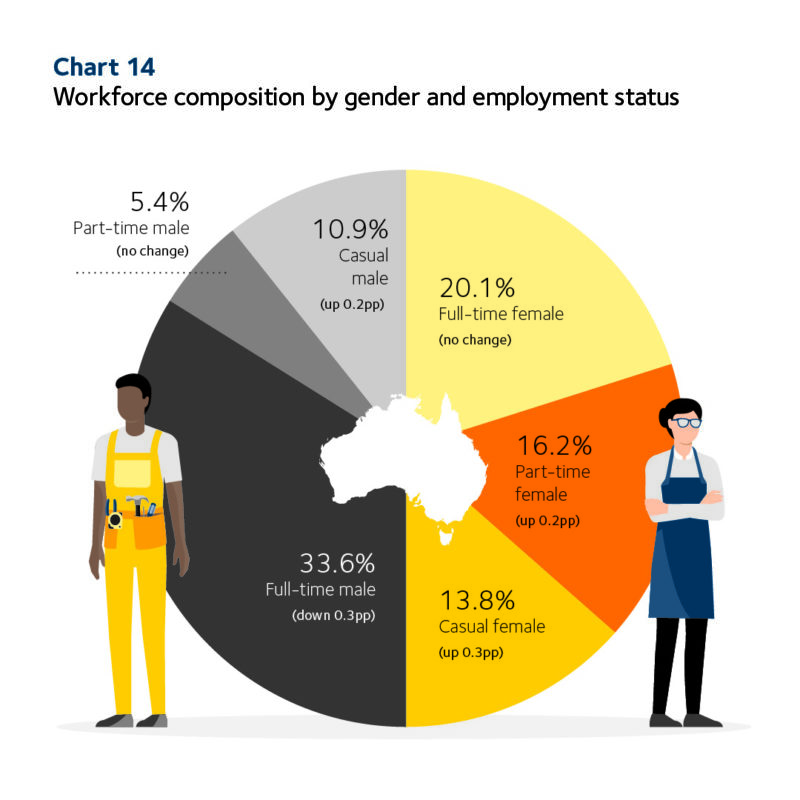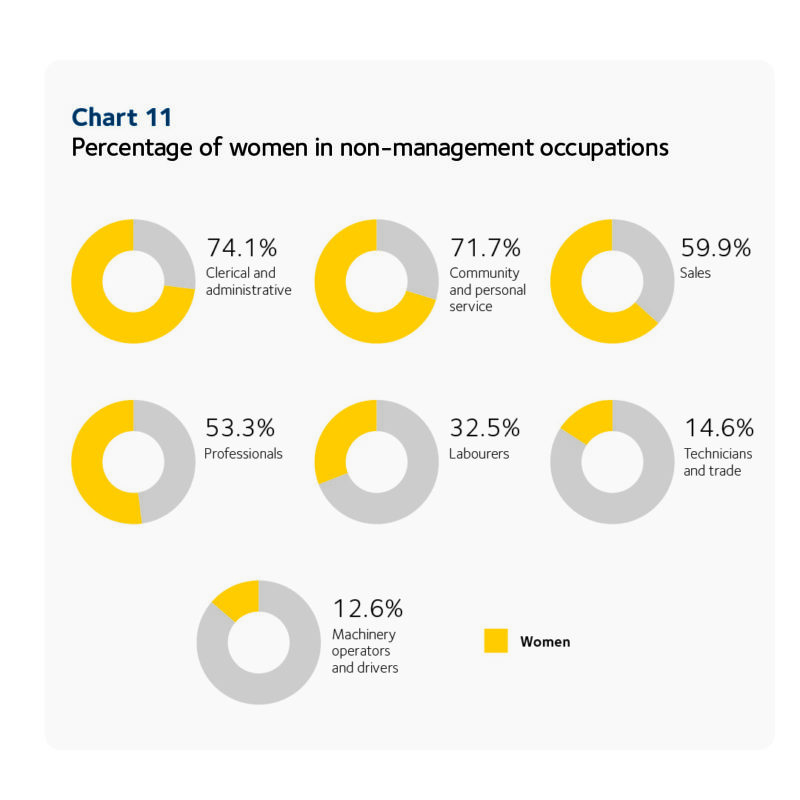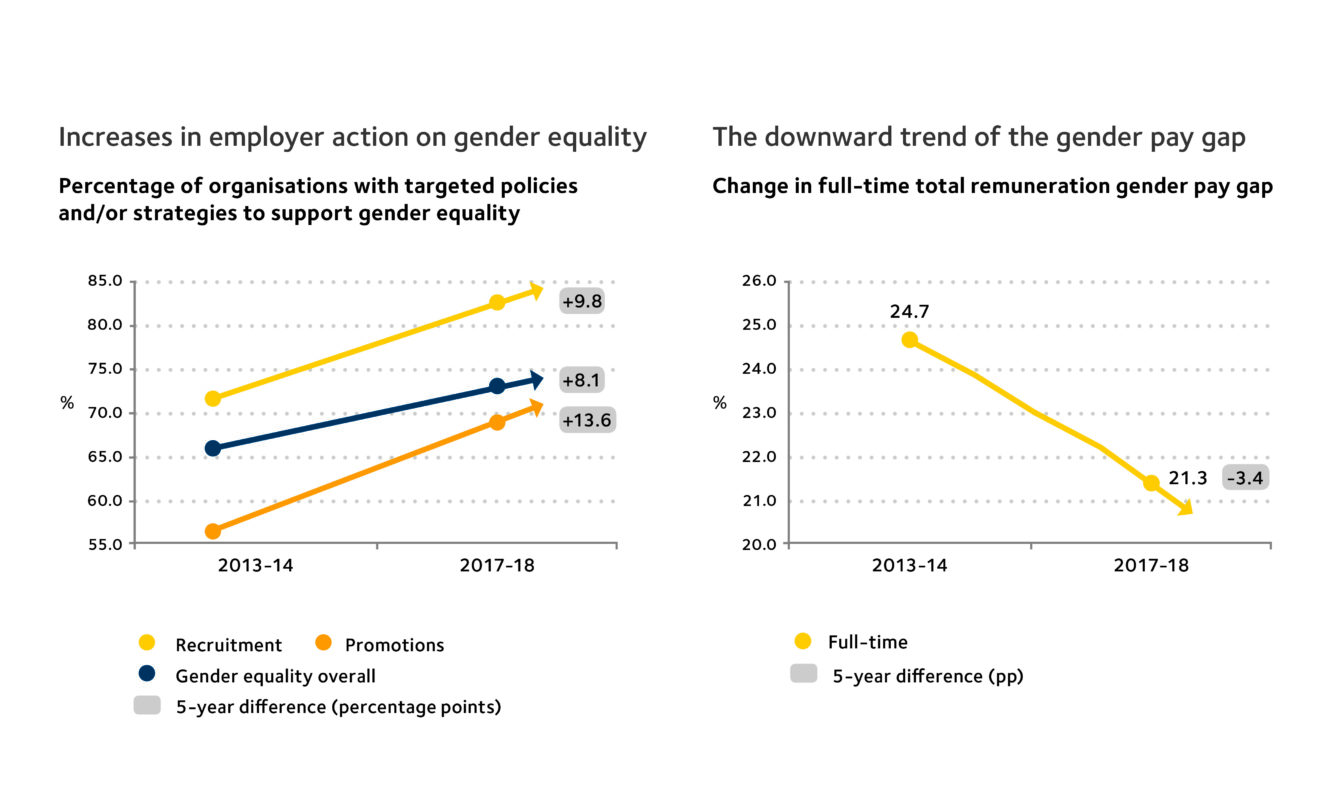Slowly but surely the gender pay gap is narrowing, but pay parity could still be half a century away. HRM breaks down the new report and examines a useful case study.
Five years of data from the Workplace Gender Equality Agency (WGEA), a government led initiative, shows that the pay gap between male and female employees has continued to drop. Indeed, 2018 saw the biggest single year drop – down 1.1 percentage points from last year.
While the movement towards an evenly paid workforce is gathering momentum, there’s still a far way to go with men taking home 21.3 per cent (around $25,700) more than their female counterparts, on average.
WGEA director, Libby Lyons, says: “We have clear evidence that employer action delivers real results and we should recognise the great work many employers have done in addressing issues such as pay equity. As employers have taken action, the gender pay gap has declined and gender equality outcomes for women and men across Australia have improved.”
Here’s HRM’s breakdown of the report.
Industry specific
WGEA based their data on 4,644 gender equality reports that were submitted between April 2017 and March 2018 (an annual requirement for non-public sector employers with 100 employees or more). The reports are representative of four million employees across Australia.

While overall the results show a decreasing pay gap, there are some industries that are going in the other direction.
The construction industry saw a two per cent increase in the gap, which is now sitting at 29.4 per cent. The most female-dominated workforce, health care, saw male employees accumulating higher salaries for the second year running, jumping up by 1.4 per cent from a 14.7 per cent gap in 2015-16 to 16.1 per cent in 2017-18.
The top three industries with the smallest difference in pay is public administration and safety (4.9 per cent), wholesale trade (8.5 per cent) and education and training (9.7 per cent).
The industry with the highest pay gap is financial services (30.3 per cent) although it has declined steadily over the last five years.
A case study
One financial services organisation that’s making strides towards a gender equal workforce is HESTA, the $46 billion superannuation fund for those working in the healthcare industry.
In 2016, the fund applied for Employer of Choice for Gender Equality citation from WGEA. To do this, it was required to conduct an in-depth analysis of its current gender balance state. This process resulted in some important realisations.
The fund reviewed salaries by gender and across various business units. When synthesizing the results, it looked at tenure, role changes, career breaks and parental leave uptake.
HESTA was happy to see that the results put it in a good position – no major discrepancies were revealed. But the findings did encourage them to challenge traditional thinking around resource allocation.
When looking at their organisational spend on learning and development through a gendered lens, the fund saw that pro-rata training budgets for part-time employees (a female dominant section of their workforce) was limiting development opportunities. To counteract this, they reallocated the training budgets for part-time employees to ensure equal access.
They also found that their flexible work and parental leave policies were mostly being used by women, which sparked conversation about the impacts – to both a business and the individuals – of so few males taking carer’s leave.
As a result, HESTA started career coaching for both women and men who were going on and returning from parental leave. It also implemented a parental support program for dads.
“Where there is a gender imbalance in caring roles, there will always be one in the workforce. And as women and men increase sharing parental and elder care responsibilities, there will be more equal representation of women and men at all levels of the workforce,” says Sophie Sigalas, HESTA’s executive, people strategy.
HESTA says it now uses the annual analysis “as an essential part of influencing areas like workforce planning, strategic planning, recruitment and selection strategy, capability and learning planning”.
More women in management
A big part of closing the gender pay gap is increasing the amount of women appointed to leadership positions. The WGEA report shows that women now comprise almost 40 per cent of managers; 43.3 per cent of manager appointments were awarded to women in 2017-18.
Nearly a third of key management personnel (those who sit under the CEO level) are women.
However, the glass ceiling is not yet shattered. CEO appointments crept up only slightly, rising less than one per cent to 17.1 per cent representation, as did board appointments which now sit at 25.8 per cent.

It’s not just the glass ceiling that’s still intact, so is the glass wall. There has been minimal movement in the gendered role segregation space over the last five years, with only two industries moving from male-dominated into “mixed” – the professional and scientific and technical services sectors. Interestingly, the telecommunications and media sector took a step in the opposite direction moving from a mixed-gendered sector into a male-dominated one.
People and leadership expert and founder of HR Gurus Emily Jaksch, takes a different perspective. While she says it’s encouraging to see year-on-year improvement she also believes that many of the statistics fail to consider the “multitude of factors, other than sexism or discrimination, that contribute to the pay gap”.
“The real pay gap is between mothers and fathers, not simply men and women,” she says.
“The recent WGEA study findings show that we have more female managers but not CEOs. Does this take into account the fact that [some] women aren’t interested in pursuing careers that consume their lives? How many women do you know who are willing to raise [two], work 80 hours a week and live at work? Not many. Coupled with this the fact that we still have no real improvement in paid parental leave or flexible work options, which demands the question: how easy are we making it for women to return to work from maternity leave?”
Employers are taking it seriously
Analysis of pay equity has been on the rise among employers, with 41.6 per cent saying they have a strategy in place to analyse payroll data. Of those organisations, six in ten took action as a result of their findings.
The most proactive industries (that take action after analysis) were: mining, information media and telecommunications, and the financial services industry.
Female-dominated retail trade was one of the industries where employers were least likely to take action after their pay gap analysis.

Still 50 years behind
While the report signifies a step in the right direction for gender parity, more needs to be done.
As detailed in a Sydney Morning Herald report, the federal Labor party has signalled that under its government, compulsory WGEA reports would be made public and organisations could be “named and shamed if they fail to comply, and excluded from lucrative government contracts”.
Lyons, who acknowledges the positives of a narrowing gap, still believes that “progress it too slow” and told the SMH that “Australia is still 50 years away from closing the pay gap”.
“The first five years of data shows where we are seeing positive change and where we need to make more effort. We now need even more employers to take action so that we can accelerate the momentum for gender equality in Australian workplaces,” says Lyons.
Build awareness in your organisation of both conscious and unconscious bias and its impact on decision making in the workplace, with the Ignition Training course ‘Managing unconscious bias’ which can be delivered in house.


The public service and a number of organisations are still using incremental pay systems which are a key source of discrimination. If you look at UN ILO Ch 100 equal pay for equal work it is systems like old outdated incremental pay systems that create inequality. I note reference to work tenure in the article – this will impact the equality in an enormous number of organisations.